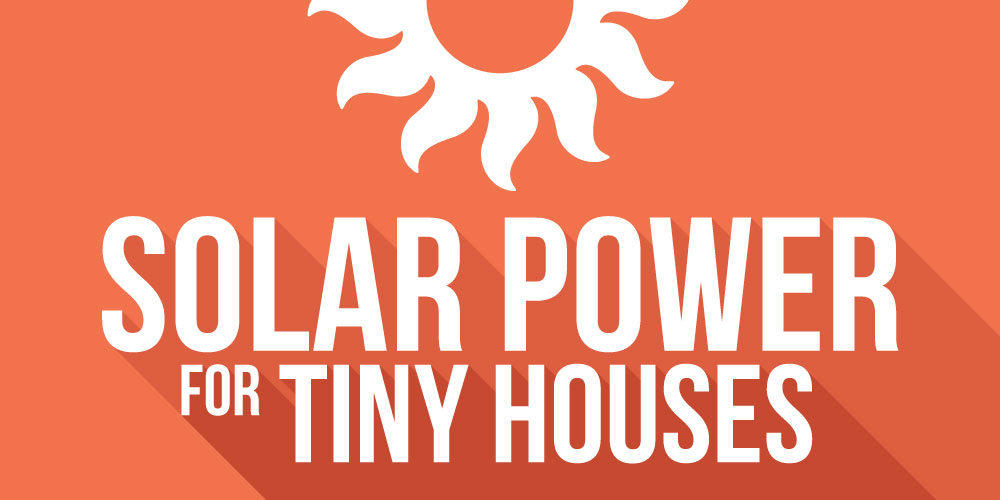
It’s hard to imagine that I’ve been powering my tiny house off solar panels for my tiny house for over 7 years now! Not having a power bill for almost a decade has been incredible. With that in mind, I wanted to get some real-world experience with my system to give you all the full picture of what it’s really like to power your tiny house with solar: how many panels, how much does it cost, and more.
Solar Panels For A Tiny House

Many people have asked me about putting solar panels on a tiny house because I’m one of the few out there that is totally off the grid in my tiny house. I’ve had to figure things out like how to run my air conditioning off solar, how to cook with solar in a solar oven, and how I use solar generators as backup power in a pinch.
Tiny houses are a great candidate for solar power because the smaller space makes 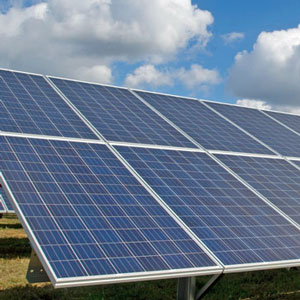 for low power needs. While the traditional home in America uses around 30 KWs per day, my tiny house uses around 3 KWs per day.
for low power needs. While the traditional home in America uses around 30 KWs per day, my tiny house uses around 3 KWs per day.
Every decision I made during my tiny house build, from choosing LEDs lights, to a super-efficient minisplit system, and an on demand hot water heater all were chosen to reduce my power consumption. Since I built my own house, these decisions were pretty simple and, in the end, didn’t cost me much more. Any additional costs for things like a high SEER rating HVAC system quickly paid for themselves by letting me have a smaller solar panel array and batteries.
How Much Power Does A Tiny House Use?
A tiny house will use around 4 KWs per day. Typically, around 80% of that power will be used for heating and cooling, assuming you cook and heat water with propane or natural gas.
Here is an example of my power usage breakdown:
- Minisplit (heating/cooling): 3,000 watts per day
- Fridge: 780 watts per day
- Lights: 100 watts per day
- Cell Phone: 30 watts per day
- Laptop: 240 watts per day
Total: 4,150 watts per day
How Many Panels Do You Need To Power A Tiny House?

15 solar panels will power a typical tiny house. This assumes an average sized solar panel of around 300 watts, which would generate around 4,500 watts of power from the sun. This would cover all your power needs including some heating and cooling, but require you to have a gas cook range and a propane heated hot water heater. If you live in a particularly cold climate, you’ll most likely need to supplement your heating with a propane heater too.
How many solar panels can you fit on a tiny house roof?

Generally speaking, you can only fit around 2 solar panels on a tiny house roof. This presents a real challenge because today you can really only expect to make around 20 watts per square foot of solar panel in ideal circumstances. That means you’re only going to be able to fit around 600 watts of solar production on a tiny house roof, which isn’t a whole lot.
Mounting Solar Panels On A Tiny House Roof

Many people want solar panels on the roof of their tiny house, but I opted for a ground mounted solar array, which I highly recommend. Tiny house roofs only have around 200 square feet of space and since most roofs are pitched, you can really only mount panels on one side. This means you only have around 100 square feet of space for panels.
What I did was mount my solar panels on stands on the ground. After considering all the options: roof mounted, pole mounted, solar trackers, and fixed ground mount, I’m really happy with my decision.
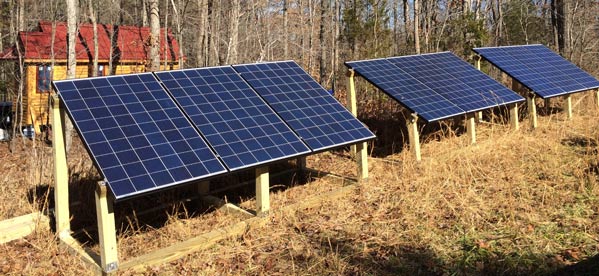
The benefits of a ground mounted array are huge: being able to easily clean my panels, clear off snow that covers my panels after a snow fall, keeping the panels cooler (increases their efficiency) and being able to shade my house while placing the panels in an open field.
The biggest benefit of ground mounting my panels is that I could have a way bigger solar panel array. This meant instead of 600 watts on the roof of my tiny house, I could put 4,000 watts on the ground in the field right next to my tiny house.
My Tiny House Solar Panel System:

To get your tiny house setup on solar you’ll need the following parts: your panels, batteries, a charge controller and an inverter. Simply put, your solar panels take the energy from the sun an converts it to DC power, that then flows to the charge controller which regulates the flow of power to the batteries or the inverter, the batteries stores power for later and the inverter converts the DC power to AC power, which your house uses.

Here’s the key details of my solar power system:
- 3,975 (3.9 KW) of panels Schneider SW 4024 – fifteen, 265 watt panels
- 1,110 amp/hr battery storage
- 24 volt system
My Tiny House Solar Setup:
- (15) Canadian Solar CS-6p 265 Watt Poly Black Frame
- Schneider SW 4024 Inverter
- Schneider MPPT 60 Charge Controller
- (12) Trojan L-16 6v 370 AH Flooded Lead Acid Batteries
- Schneider System Control Panel
- Schneider Interconnect Panel
- Midnight Solar MNPV 80AMP Dinrail Breaker
- Midnight Solar Surge Protection Device AC/DC
- 50 Amp RV power Inlet
How To Build A Solar Power System For Your Tiny House

Before anything I needed to determine the best placement for the solar panels to make sure it had good solar exposure and didn’t fall into shadows too much. To do this I used a tool called a “solar path finder” which is a semi reflective dome that you position at the location, then snap a photo.
The photo is then loaded into a program and spits out a whole bunch of calculations.
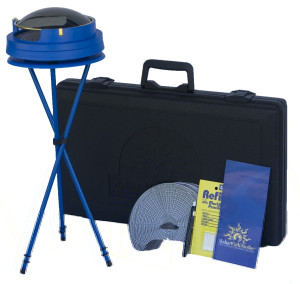
Calculating Power Production

Once you upload the image into the software and then trace the tree line outline, you enter in your location, date and time. It then can calculate how much power you’ll produce based on 30 years of weather patterns for your exact location and tree coverage. Then it spits out all the calculations:
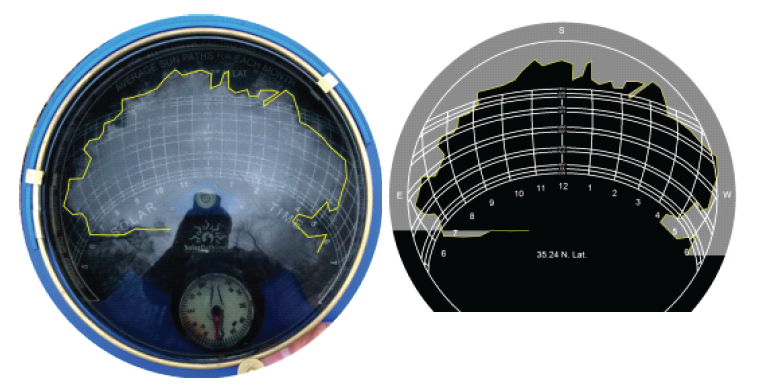
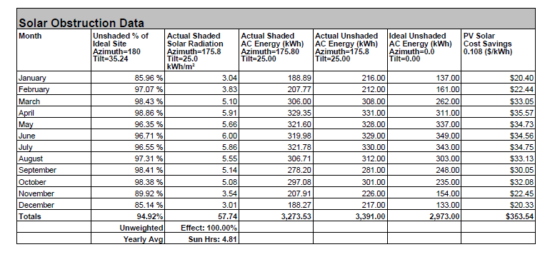
With that in mind, I knew what I could expect out of the system I had designed. It also was a way to verify my assumptions.
Once I verified that the system was going to be well suited to my needs, I had to build my panel support racking. I did this out of pressure treated 4×4’s that were each 10′ long. These things about 300 lbs each so I don’t have to worry about the wind picking up the panels.
I opted to build them because it was cheaper than some of the turn-key option out there and most of the for purchase ones required me to cement in the ground; I rent my land, so I wanted a mobile solution. If I remember correctly it was about $500 in materials to build this part.
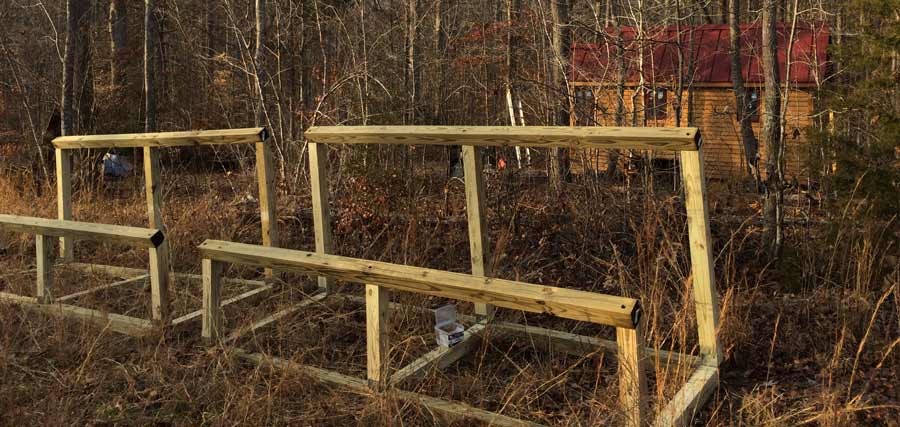
Many people have asked why I didn’t mount these on my tiny house roof. You technically can mount on your roof, but honestly, the number of panels that you need to practically power your house is too many for the roof.
There are some other major bonuses of being on the ground:
- Much cooler, roofs are very hot places in the summer and solar panels drop in efficiency when hot
- I can put my house under deciduous trees, this means in summer I’m in the shade, in winter I get the solar gain
- Way easier to clean and monitor
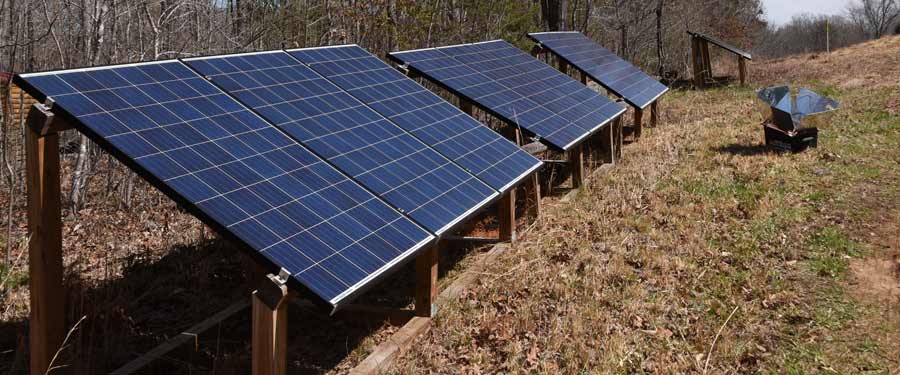
Cleaning your panels is pretty important because you loose efficiency as residue (bird poop) builds up. Also, as I learned just a few days ago, when it snows, you need to clear your panels. Cleaning becomes super simple and a lot safer when you don’t have to climb onto a roof via a ladder.
Just this week we got a decent snow, 3 inches, which is quite a lot for Charlotte. The first thing I had to do when I woke up was clear off the panels because, with the snow, they made no power. This was compounded because since it was cold, I needed more heat. I can’t imagine having to drag the ladder out and try climbing on an icy roof… No Thanks.
Choosing To Wire For AC Or DC From Solar

Many people have read around the internet that DC (direct current) is a more efficient power way to power things. Generally speaking, everything in a traditional house is wired for AC (alternating current), but if you’re putting solar in a tiny house and building your own house, the question becomes relevant when you’re starting from scratch. Solar panels produce DC power, so you have to decide how you’re going to handle it.
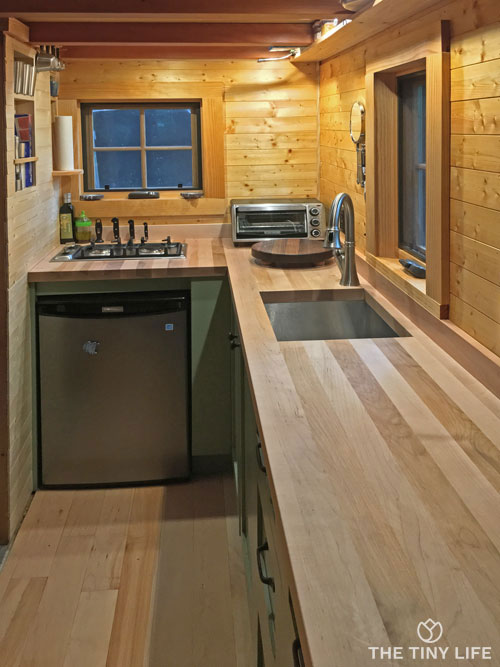
Most of the advice to wire a house for DC power comes from older sources who haven’t updated; these could be old articles written on the topic (consider anything more than a year out of date with how fast solar is improving) or from someone who hasn’t caught up with the latest equipment.
Back in the days, the drive to wire a house in DC power comes from two main things: there was power loss through inefficient inverters (converts from DC to AC) and from the fact that on paper DC is, in fact, more efficient.
Where this falls down in modern times is that inverters have come a long way and while there is some loss in power through the converting of AC to DC, it’s quite minimal. The other factor here is that any inefficiencies (of both the conversion to AC and the less efficient nature of AC) can be easily offset by the addition of 1-2 panels to your array.
This begins to make even more practical sense today because if you wire for DC, you’ll be limited to DC powered appliances, which typically cost two to three times the cost of their AC equivalents. That all means that you can actually have more power with AC, even after the losses through inefficiency, for less money. This is because the savings from going to AC appliances over DC will leave you with more cash, even after you buy 1-2 more panels.
To put it simply, convert to AC, add a few more panels to your array and stop worrying about AC vs DC.
Installing Solar Panels For My Tiny House

After calculating the ideal location and building my stands, I installed the solar panels. This part was pretty quick and the stands worked out perfectly. The panels are 250 watt Canadian solar panels. They are wired in groups of three, then paralleled into the system. To give you a sense of scale, these panels are 3.3 wide and about 4 feet tall.
Building My Battery And Inverter Cabinet

Next, I built a cabinet to house all the gear. I wanted a stand alone space because the batteries are so heavy. At 118 pounds each, plus cabling and other equipment, the whole unit is over 1,100 lbs. The top and bottom sections are divided so that the gasses from the batteries don’t go up into the electrical section for a very important reason.
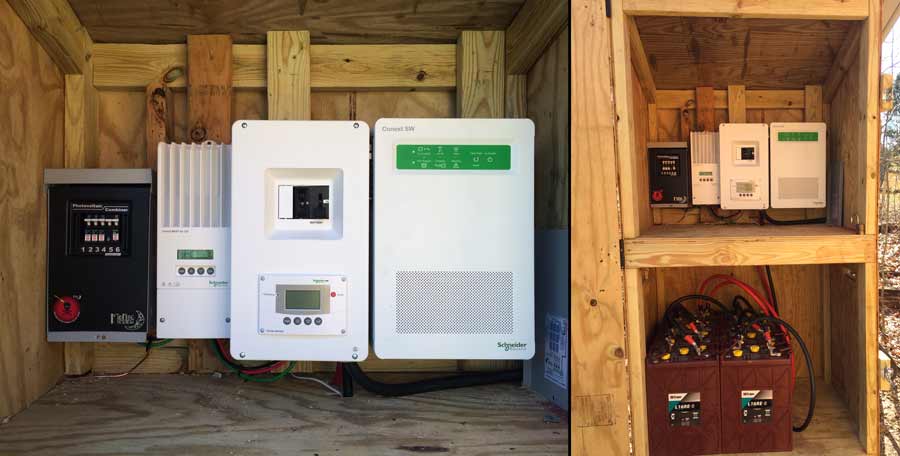
Looking at the cabinet, on the sides of it, you can see the vents. When you use lead acid (LA) batteries you have some off gassing as the batteries discharge and recharge. These gasses are volatile and can ignite, possibly leading to an explosion. To take care of this I installed two vents like this which provide adequate venting.
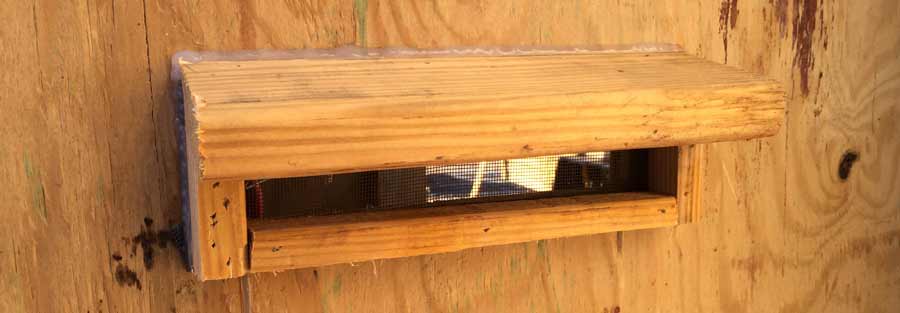
Choosing Batteries For A Tiny House Solar Panel System

I choose lead acid batteries over AGM (absorbent glass mat) because LA’s have more cycles and cost a bit less. Lithium Ion at this point is cost prohibitive, around $10,000 for the equivalent capacity. I choose these 6 volt batteries because it was more economical over other options and trojan is a pretty reputable name in the industry.
My batteries should get about 4000-5000 cycles (11-14 years) before I need to replace them. I figure in about 5 years battery technology will have progressed so much I’ll change early. New batteries will cost me about $5,000 of the lead acid variety.
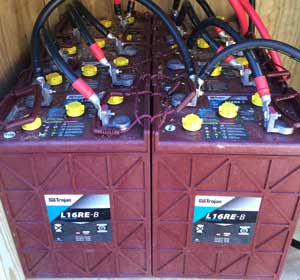
Wiring My Batteries For 24 Volts

The batteries are wired in series parallel. The batteries are 6 volt each, in series of 4 the create a 24 volt unit. Then I have two of these 24-volt units in parallel. The reason I choose to go 24 volts over a 48 volt (which is more efficient) was that the equipment was a little cheaper and it allowed me to future proof my setup.
Future Proofing My Solar Panel System

Going with a 24 volt system also allowed me to select components that I could add more panels and batteries very easily without doing equipment upgrades (just a factor of the abilities of the units I choose). This way I can add up to 15 panels and a lot more batteries without upgrading the electronics. A big draw for me to the system I choose was that I can also stack these inverters, so if I ever go to a normal sized house, I just add another unit and it just plugs into my current one.
Wiring A Tiny House For Solar

In this photo going left to right: Din Breaker Panel, Charge Controller, Interconnect w/ control panel, inverter.
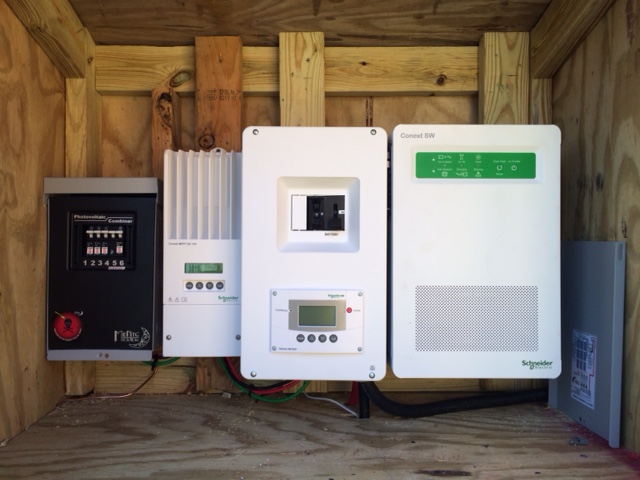
In general, the power flows in the same manner (but not exactly).
- Breaker Panel: manages power from solar panels
- Charge Controller: manages power to batteries etc.
- Interconnect: a main junction box and breaker, holds control panel interface
- Inverter: takes power in many forms then outputs to the type of power you need
How To Connect Solar To A Tiny House

Once the power goes through the system it outputs from the inverter as AC power. This AC Power flows out through a huge cable that you can see sticking out of the bottom of the inverter then goes right. From there it runs to this:
This is a 50 amp RV style plug. The reason I did this was twofold. City inspectors are less picky when it comes to non-hard-wired things. This setup also lets me roll into any RV campground and hook up seamlessly.
The plug goes into a 50 amp RV female receptacle. This is important that you don’t have two male ends to your cord. This is dubbed by electricians as a “suicide cord” because if you plug into a power source, you have exposed conductors that are live; accidentally touch them, you complete the circuit and zap!
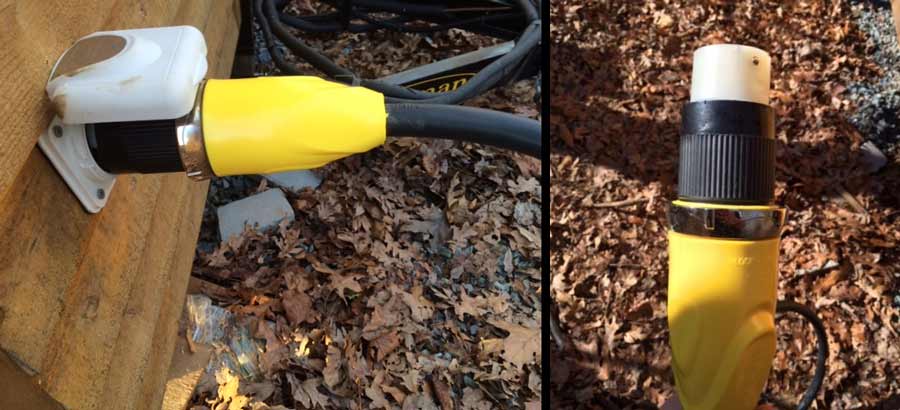
You want a female end to your cord so that you reduce the chance of being shocked. I also turn off my main breaker at the power source when I make this connection, then turn it back on.
If all these mentions of watts, volts, amps, amp hours etc are making your head spin a little, you may need to go back to the basics. I have an ebook called Shockingly Simple Electrical For Tiny Houses which guides you through all the basics. As of now, it doesn’t go too deep into the solar aspects, but the basics of electrical, wiring, power systems and determining your power needs are covered in depth and designed for those who are totally new to the topic.
So once the power passes through the power inlet it goes to the panel. Near the bottom you can see the backside of the power inlet, it has a large black cord coming out of it, into the box and ties to the lugs. From there it goes out to the house.
Grounding Your Solar Array

Here is my grounding wire for my system. This is actually one of two, another is located at the panels themselves. My house is also grounded to this through the cable hook up and to the trailer itself.
A really important note: ground depends on a lot of things, one of which is if you house electrical panels is bonded or not, if you don’t know what that means, read up on it, it’s very important.
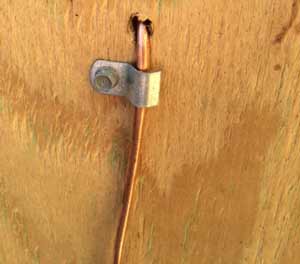
Using A Backup Generator

The other component of this system is the generator which I used for the first two years and then opted to upgrade my system because they were such a pain to use. In the winter months, I sometimes needed to top off my batteries every now and then, basically when it’s been really cold and very cloudy for a week or more.
I had a Honda EB2000i already which I really like. It’s very quiet and small. The one downside to the Honda is that it only does 1600 watts and only 120V and I needed more power and 240V. To charge my batteries, I had to have 240 Volts, which lead me to get another generator, a 5500 watt 240 volt Generac for $650. This generator proved to be a major headache and lead me to upgrade my system just to not have to use it anymore.
Here is a video that compares the two generators in terms of size, noise, output, and price.
Tiny House Solar Panel System Costs

The big question when it comes to doing solar or not is of course cost. Everyone would like to have solar, but costs are a real barrier. My decision was made pretty easily when the power company informed me that I would have to pay $15,000 just to run their power line to my house, only to have a power bill each month.
My initial version of my solar panel array and batteries cost me around $14,000 with the added benefit of no power bills ever again and a $7,500 tax credit back, the decisions was a simple one. I later upgraded to a larger system for another $5,000, of which I got another $2,500 tax credit.
So, for me, I was able to actually save money from day one. That said, I had to bank roll that huge cash payment which most people cannot do.
Here is a rough break down of costs for my upgraded solar panel system:
- Inverter: $4,500
- Charge Controllers: $1,200
- Control Panel: $300
- Batteries: $4,000
- Solar Panels: $4,000
- Breakers + Boxes: $800
- Battery Cabling: $300
- PV Wire + House Tether + Romex: $500
- Electrician (labor): $2,000
Is Solar Practical For Tiny Houses?

In general, I think for tiny houses in one spot, solar is very realistic. Even if you don’t start out on solar, the cost savings of living in a tiny house can let you save up for the install pretty quickly. When I rented an apartment, I was paying $1500 a month, compared to my tiny house that costs me about $15 a month (not a typo). Living in a tiny house allowed me to save a ton of money while having a comfortable home.
So that’s the surface level details of the system, I’m going to be doing something in the future which will be a how to size, choose parts, hook up and all the other details of doing solar for your tiny house.
Your Turn!
- Do you want to do solar for your tiny house?

Do you live in the US? How did you figure your tax credit? I thought the credit was only 22-26% of the total cost?
Probably important to add equipment efficiencies in calculations of daily energy requirements. Inverters have a parasitic load and solar panels lose efficiency at higher temperatures. These losses can be significant and lead to undersizing array
Normally they work at 65% efficiency of their supposed real power output.
Must be into account at the moment of calculating your power generation.
Solar is the present and it is efficient to use for a daily energy requirement.
The route I personally took here in East Tennessee, was to spend $2,400 on a Mennonite-built 8′ by 12′ Galvalume-roofed offgrid tinyhouse-shell of my own design, another $750 on spray-polyurethane insulation, $1,600 on a piecemeal, DIY 1.3 KW solarpower system, then assorted 12V DC LED interior lights and 3 exterior 12V motion-detector lights, 12V rainwater pumps supplying sink and shower.. I bot a 2.1-cf Sunstar 12V fridge, augmented my smaller 12V fans (them drawing cool underhouse air) with a powerful, efficient 20″ one from Western Harmonics; I use my 1,500W msw inverter only for a coupla powertools. Very happy with my system and its avoided costs.
Hi Steve,
I’m Eric. Sounds like did just fine to me. From what I could figure from your post you have all that for about 7k ??? Is that right? I live about 40 minutes North of Bristol right off 81, if you’re not too far, I’d love to check ya out sometime. Gotta love love those Mennonites, ya know that’ll NEVER break 😂🤣😂 I dunno … if you’d be up for that or not, but if ya would, gimme a Holler, and come down and see ya in the Holler. Take care Sir ✌️
Hello sir I had a very concerning question about this comment regarding the building of this tiny home. I am wanting to properly prepare and get as much individual experience from others! Thank You and Thank you for replying if you do!
Hi, Devin. I’m still a bit befuddled about the layout of the ‘replies’ format here (unless a reply-chain mentions a specific person’s name in a posting), but I today got an emailed ‘thetinylife’ update highlighting my July 2021 post, with your ‘concerning question’ post directly beneath it, apparently specifically directed to me. So if you have any specific Q’s about what (I’ve) done, I’ll be more than happy to reply. (And Ryan hereby has my blanket permission to supply any of you you my email addy, if desired.) -Steve L.
hello Steve L. I too am confused with this comment format as I just received an email from someone commenting on here but I did not receive one for when you replied to my comment so I will go ahead and say, I am thoroughly interested in the tiny house building process and I would love to have a conversation/ask specific questions over email! Thank you again Steve!
good day sir, you did not discuss how are your solar panels connected? is it in series/parallel and why? also if you have a article regarding current calculation in a solar power.
thank you very much!
mabuhay po kayo
My friends,
I loved the fact that you have a solar option.
My company sells rainwater harvesting tanks. I believe that every Tiny home should have a rainwater tank – by adding this component, you are truly off the grid. I have many options for the tiny home market. Lets make this happen.
That’s great for you American cousins…unfortunately, here is Australia, we get overcharged extensively (for EVERYTHING + we don’t get the range of goods you cousins do!)…for example, the batteries alone would cost just under 100% more here in Oz and we get no credits on tax at all!!!
Thanks for the article, lots of good information. I was going over the numbers to compare with the design I’m working on and have a few questions/comments, hope you don’t mind.
You seem to use solar and photovoltaic (PV) interchangeably, since HVAC is 3/4s of your system did you look into solar thermal for hot water and space heating to reduce the electric load?
You stated 3-4 KWH per day, that would add up to 90-120 KWH per month, with a 4 KW array that would be only 25 – 30 Hrs of sunshine a month which seem very low, many place are more on the order of almost 100 Hrs/month at least in the summer.
What about a much smaller system, without the HVAC. Heat could be handled with solar thermal or propane. A backup generator charging the batteries more often could reduce the need for panels further. Now we are looking at 1 KWH/day or 30 KWH per month. 1 KW of panels and the equivalent of 2 batteries running 12 VDC should suffice. There are lots of automotive/RV 12 VDC devices to choose from these days. Also, instead of a fridge how about an ice maker and ice box. You could make ice only while the sun shines and reduce the need for batteries even more. Ice could also cool when fans are insufficient. Since this is in the summer, there should be more sunshine. You could also try an absorption AC unit which runs on solar thermal. The generator might run more but the trade off would be a bit more fuel for a much smaller system say less than 1/4 the size. Since prices are always coming down starting off with a minimal systems seem prudent.
Thanks again,
MJ
Great summary of what is involved with supplementing the energy requirements of a trailer house using solar-electric power. Your point about using solar “for tiny houses in one spot” rings true.
Initially I thought to go full solar electric. An online electricity use calcuator placed my conservative kilowatt usage at an estimated 11kw/month. A solar system which could meet 12kw required about an 850 square-foot array. Hmmm, the foot print for my tiny 20′ x 8′ trailer house is 160 sqft but the solar array would be more than five times that!
It is good to know these things. It does not mean that I could not build such an array with enough power to meet all of my energy requirements, after all, a 25′ x 34′ cover could serve as a car port, mini garage, tool storage, or gym – or a combination of those.
Thanks for sharing.
– Eric
Hi. Steve again. I last posted on 7/31/21. Propane prices are increasing by 54%, and I’ve just installed, on individual/separate switches, (six) 2.5″-square, 12VDC,100W-each electric miniheaters with integral heatblowers, operated, like everything else, from my offgrid 1.3-KW solarpanels array and 2.3-KW AGM batts-bank. With nights now dipping down into the 20’s at times, my sprayfoam-insulated tinyhouse’s drawcurtained-bunkcubby is 70-71°F each morning from mere bodyheat alone, and, using from one to three of the new 12V miniheaters (by day) to heat first bunkcubby, then my (midroom-partitioned actual-livingquarters 50% of) my 96-sf tinyhouse, has thus far prevented need for ANY propane-heat at all, this year. (Last winter, my 3-month-period TOTAL propane-cost, heat included, was $42.) In peak summer, my reflective Galvalume roof, thick sprayfoam & other incremental, retrofitted insulation, plus deep South/West solarpanels-roofed, walls-shading ‘canopies’, and cool underfloor air blown upwards from floorgrates to gable-exhaustvents, keep INside surfaces always-COOLER than my body’s SKIN-temp, so my body thus radiantly-LOSES its heat TO my cooler indoor surroundings, rather than vice-versa; on summer days in the upper-80’sF, when sun-heated outdoor objects measuredly hit 154°F, I’ve even popped gooseflesh, begun shivering, and had to REDUCE indoor airflow! I’m presently busily hunting better-located lease-land, to have my ~$6,500 tinyhouse moved 20 miles further west, to be in same town as my grown kids and grands. -A future summertime aircooling earthtube and some wintertime PV-heatstorage are two long-considered possibilities.
Very concise and helpful. Hope you are still doing well.
Great Article Love It and ant to learn more. Can you help with plans that I can acess.
ThanksKen
Wow!! Amazing blog. you are really a great writer. your solar panel procedure is really great. Solar panel installation is important for saving money and the environment.
This is soooo well done! Thanks so much for such a straight forward and easy to understand article.
Thank you for this baseline of information. I will plan to invest in your book when I get closer to the reality of actually having my tiny home built. I like the idea of having panels separate from house, there are many arrays now days, ie: artsy flowers that rotate with the sun, etc. (Likely or of most budgets, but idea of moving- is it worth checking into?) Also, I have questions about installing on side of tiny home as well as part of roof. (I am looking at a semi-permanent unit that has roof access 2 ways, from inside egress & outside — also plan to live in warm climate.) Do you think you’d be able to design a system that might even accommodate a small tiny home “community” of a few units? All things I am hoping to have the opportunity for, in Florida.
Hi, all. Just another update. As outdoor temps thus far this summer have hit as high as 95°F in the shade, I remain cool, sweat-free and comfy inside my 8’×12′ offgrid tinyhouse, despite no standard airconditioning, thanks to several design factors. -My reflective Galvalume roof, thick closed-cell foam insulation, my South and Westside walls 100%-sunshaded by solarpanels-roofed canopies & shadecloth-backed, deciduous vines-entraining latticework, and finally by my solarpowered 12V blowers that siphon-in cool underfloor air that exhausts at 8.5′-height from similarly-solarpowered gablevents. My interior surfaces thus at all times stay cooler than my body’s 91°-92°F skin-temp, which at full airflow-settings on 95°F days can still, largely thru resulting ‘warmer-to-cooler’ RADIATIVE bodyheat-transfer, be dropped to a gooseflesh-inducing 85° skin-temp, with both the bone-dry underfloor earth and a new 12V, 60W dehumidifier both decreasing the humidity-% of the well-shaded, subfloor air blown-in. I open a door and a window nightly until sunrise, with floorgrate-intake and gable-exhaust blowers left on nightly as well.. I’ve now expanded my DIY’ed 1.3KW solar array to 1.5KW, and am still contemplating installing a closed-loop, underhouse aircooling-earthtube, if/when Tennessee summer temps begin exceeding 100°F.. Here’s hoping that everyone manages to stay safely-cool, this summer, everyone..
This is wonderfully comprehensive. Looking forward to your post on how to size, choose parts, hook up and all the other details of doing solar for a tiny house. I am actually most curious about how you came to decide on 1100 Ah battery storage as this seems like quite a lot given your consumption estimate of 4150 Wh/day.
Is there a full list of things that I need to buy?
Thanks very helpful
Great article. You convinced me this is the way to go.
Good information.
I would like to do solar powerfor an RV/ tiny house resort, is it possible?
OH MY GOSH THANK YOU!!!!!!!!!!!!!!!
Your article answered the MAIN question that (for some reason) I couldn’t get ANYONE to answer for me (being a complete newbie with no knowledge of solar systems) – which was…
Can I set up a system with batteries (that can be expanded) — where-in I utilize a gas generator, for not-only emergency situations — but also to power-up my batteries (for both emergencies and also for learning about the limitations and needs of my system).
For some reason — no matter how hard I looked and who I asked, NO ONE had that answer for me! Their response was always, either: “Well it depends…” — or it was an answer that had nothing to do with the actual question I was asking.
Thank You SO Much for sharing your experience, and for providing further reading material. I have downloaded your free material for subscribing, and I have a feeling that I will be purchasing your book very soon.
(Now I’ve gotta re-read this article a little more slowly and methodically)…
But again…
Thank You, Sir!
P.S. It looks like you also used Divi to create your website… Same… 😉
By “Your Book” I meant the “Shockingly Simple Electrical” that was linked in the article. I wrote the last post before I realized that you have more books for sale than that one 😀
Your article was very informative and I thank you for it. I live in Lansing but will house my tiny house early next summer in Grand Blanc.
I want to be completely off grid.
Do you do installations of solar power?
Thank you for all these useful insights!
Commenting on an article at Submit Guest Post is not only engaging but also a smart way to build backlinks. A win-win for all!
Hi, thank you for this article, it is super informative! I just wanted to ask about how you manage to only pay $15 a month for your tiny home? In which article do you discuss your “mortgage” situation?
Thanks again! 🙂
C
Great article. How many panels would you recommend for an incinerator toliet??